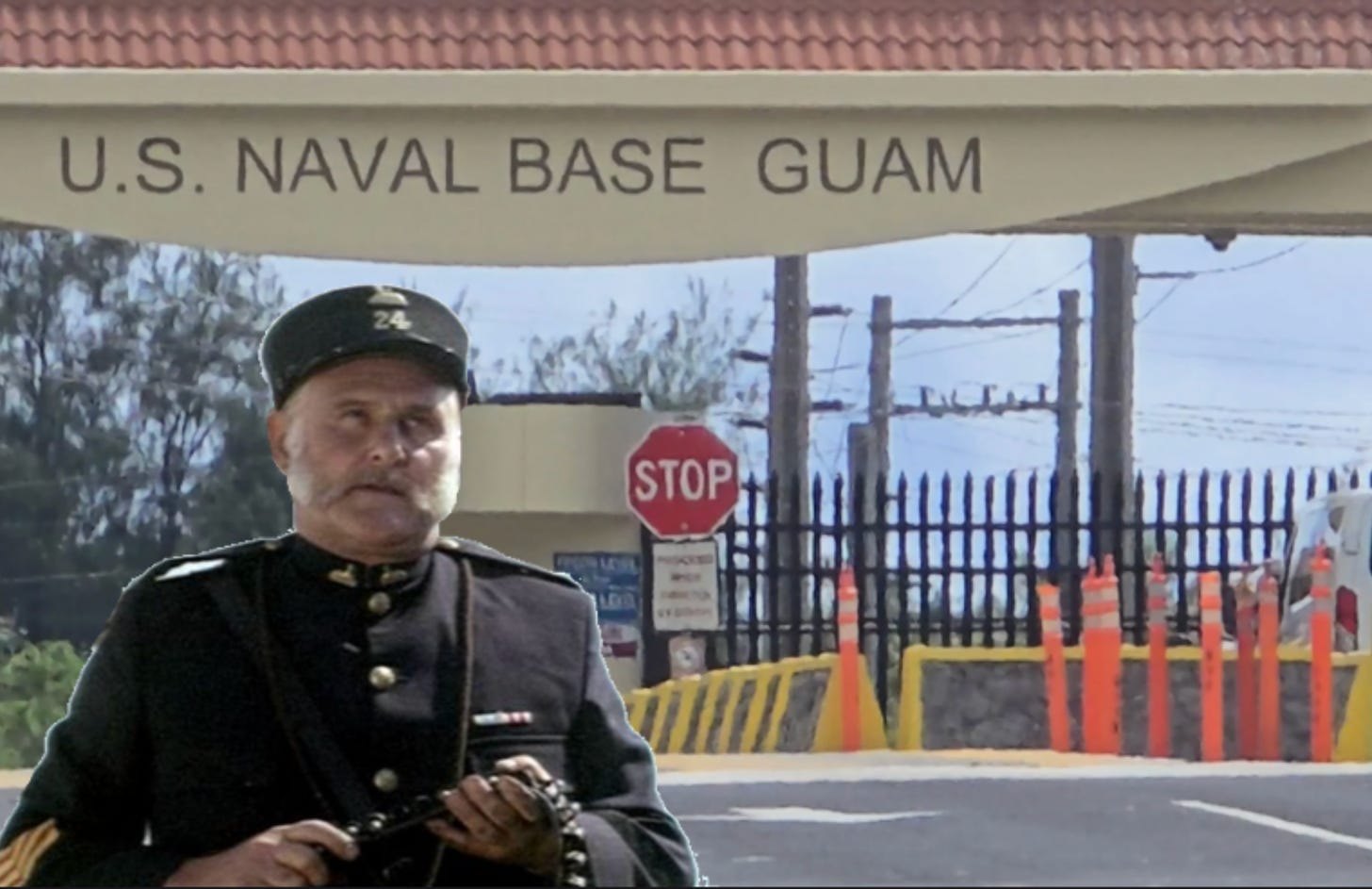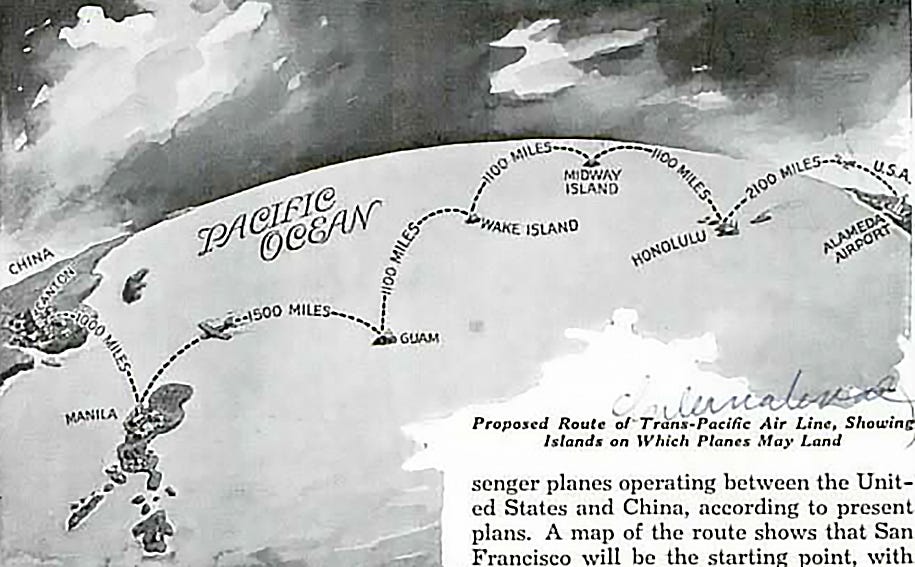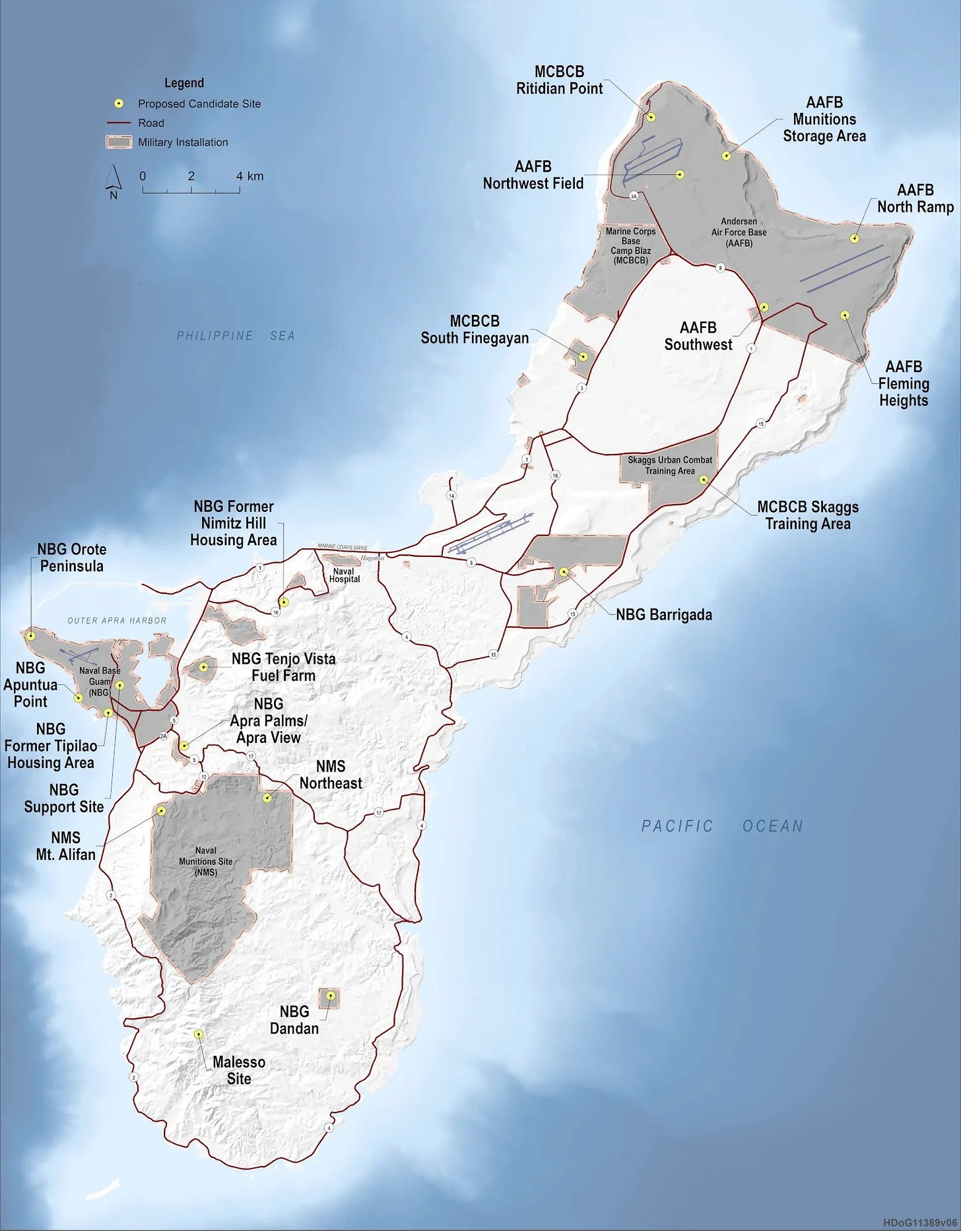Who Put Quartermaster Bloomfield in Charge of Defending Guam?
another environmental impact statement will deter China
There was one thing everyone who had a chart of the Western Pacific knew even before then President Obama’s “Pacific Pivot” over a decade ago: Guam is the key to the fight West of Wake.
Move the timeline up for the last few years. What has been understood in theory, practice, and wargaming has been made flesh: precision conventional strike from ballistic missiles.
Today’s ballistic missiles are no longer the high Circular Error Probability (CEP) ‘lob-n-hope’ of their first half-century of use, no. Even third rate powers like Iran and fourth rate sub-powers like the Houthi can hit ships and airfields in a volume of fire that saturates what air defense systems may be in place. What first rate powers like Russia and the People’s Republic of China (PRC) can do is another level or two higher.
This was a well known story when we covered it in our two-decade long “Long Game” series almost five years ago - but as we spent an entire generation and trillions of dollars pursing foolish imperial policing actions in Central and Southwest Asia, this took a back seat.
Here are the clearest final warnings from the last half-decade that should, ideally, focus our minds:
Keep in mind that the first final warning above was almost half a decade ago, more time than it took to fight WWII. If that doesn’t illustrate how broken and entitled our military-industrial-political system has become, then it's unclear what will.
The timeline you will see below involving our “hurried” build-up of air defense on Guam is just the latest datapoint. Not only is there no sense of urgency to catch up to decades of neglect, there is a complacency born from what could be little more than inept entitlement.
All the DC-centric people like to talk about “Whole-of-Government” and “Interagency” as the way the Smartest People in the Room™ solve problems — yet the late-is-the-hour attempt to defend the key to any projection of American power in the Western Pacific is being treated with the same level of dead-hand bureaucratic malfeasance as a new entertainment resort on the last bit of open beach in Hawaii.
The great national defense machine that once was the United States,is no longer fit for purpose. It serves something, but it isn’t the nation's defense.
Especially in the years after Goldwater-Nichols from 1986, the framework that guides the US military, the steady accumulation of layered accretions on the moving parts and the usual bloat and lethargy from a bureaucracy focused mostly on justifying its own existence was allowed to grow unchecked by firm leadership.
Just look at how fast previous generations developed nuclear submarines, the first generation of guided missiles, and the iterative approach to fighter jet production.
This was all done without modern communication and technology that, in theory, allows projects to progress at a much faster clip with better coordination. It isn’t technology or money that is the problem, it is people and process.
Tasks that once took only a few years now stretch into decades, as if the entire world is waiting for your multi-thousand page document to extrude from some unknown office produced by unknown people for almost no identifiable purpose to justify the time and effort.
Let’s review the state of play.
Throughout the Pacific, the People’s Republic of China (PRC) is strip mining seabeds to fill in reefs to make military bases where nothing existed before.
Shipyards powered by the most dirty coal power plants being built on the planet are churning out warships like so many Pez Dispensers spit out candy. Their factories, emitting uncontrolled pollution, are producing missiles at an unmatched pace.
The PRC has built an entire conventional ballistic missile system to do among other things; attack the American territory of Guam. Geography has not changed.
At least a half decade late—I would argue a decade and a half late—the USA is responding … or trying to respond … by increasing defensives in Guam.
How?
A proposed multibillion-dollar missile defence system for Guam has been reduced to 16 sites on the island from the original 22, the U.S. Missile Defense Agency said in a draft environmental impact statement on Friday.
The project is designed to create "360 degree" protection for the U.S. Pacific territory from missile and air attacks of all kinds, the agency said. Plans include integrating Raytheon's (RTX.N), opens new tab SM-6, SM-3 Block IIA, Lockheed Martin's (LMT.N), opens new tab THAAD, and the Patriot PAC-3, which uses components from both companies, over about 10 years.
If you look at the map above, you can figure out which four +/- were left off.
A comparison of the new sites with a May 2023 site map showing 20 proposed sites reveals that planned defenses were eliminated at a naval fuel farm, a former housing unit and supply facility at the naval base, a supply depot at the Air Force base, and a civilian site at the southern end of the island.
The plan calls for about three to five sites to be built per year, and peak construction will occur between 2028 and 2030.
Of the proposed sites, eight will be at U.S. Naval Base Guam (including the NBG Munitions Site), six will be at Anderson Air Force Base, and two will be at Marine Corps Base Camp Blaz.
We are going to take a decade to build 16 air defense sites. I think in WWII, Seabees would do it in about 10 weeks.
Maybe it is no bid deal, that 16 is as good as 20 (other sources say 21). I know this as someone who previously targeted land-based defensive systems: fewer targets are easier to defeat than more targets.
Maybe less is better, but something smells, “off.”
The draft statement said some of the site were eliminated based on system performance issues, questions about operational effectiveness, airspace impact, limits to existing infrastructure, force protection issues and cost-effectiveness.
The draft environmental statement is more than 7,600 pages long and addresses issues including the impact of high-powered missile defense radar on local aircraft communications and wastewater and drainage issues. It is required under federal regulations and remains open for public comment for 75 days.
And there it is. For reference, a standard printed Bible is usually between 1,200 and 1,500 pages long. Of course, there are always the high-emotion/low-reason people who opposed anything military, but let’s dig in to that EIS.
This is what fills up 7,600 pages.
Ground-disturbing activities would occur while the sites are being built and could take up to 12 months per site. The draft EIS said construction activities would typically occur up to 10 hours per day, six days per week. If necessary, to meet construction timelines, work at night may occur.
On the cultural aspect, site preparation and construction activities alone “could result in direct, permanent adverse effects to 10 historic properties and impact 14 unevaluated resources.”
“However, where practicable, historic properties would be avoided. If avoidance is not possible, or if there is an inadvertent discovery, resource management measures would be implemented,” the agency said.
…
Guam’s biological resources including native species are also at stake, with approximately 269 acres of limestone forest habitat within the project sites that will be removed.
Most likely to be affected by the removal of the limestone forest habitat is the population of the Mariana fruit bat, which is listed as endangered.
“Therefore, impacts on limestone forest would remain as major, long-term and significant with implementation of the proposed action.”
The document also noted significant and long-term impacts from the removal of 4,866 individuals of Cycas micronesica, a palm-like tree also listed as an endangered species.
The MDA said, “Implementation of the potential mitigation measures would
reduce impacts from the implementation of the proposed action.”
…
“Greenhouse gas emissions generated from proposed site preparations
and construction are temporary and equivalent to 0.00006 percent of the global GHG emissions, approximately 0.0005 percent of the reported U.S.
“Emissions in 2021, and approximately 2.54 percent of the 2022 GHG emissions reported by Guam’s large emitting facilities. These would result in a short-term (spread over give–10 years), minor increase of GHG emissions and no detectable GWP changes resulting from the emission levels associated with these activities. Impacts would be less than significant.”
…
As for any endangered species that may be found at the affected sites where construction work will be done, the MDA draft EIS said that pre-construction surveys would be done to identify all federal Endangered Species Act-listed plants and they would be relocated, if possible, or seeds would be collected.
I know there are serious people focused on the expected military confrontation with the PRC in the next decade. I know that a lot of those people fully understand the impact of a hundred DF-26 with a 2024 CEP raining down on Guam. What I want to know is if any of them are actually paying attention to the timeline being set out to respond to this?
Returning to a core question I've raised over the past 20+ years in discussing the challenges posed by the PRC: have any of those charged with the long-term strategic position of the USA actually contemplated the effects of a defeat of the USA by the PRC in the Western Pacific? If so, it sure doesn’t look like it.







What about the impact of DF-26's hitting fruit bat nesting sites?
Hopefully a change in administration will result from the election being held tomorrow and the new team in charge will take the steps necessary to promote “Peace Through Stength”.
You’re right… too many leaders have had too much time to effect change and they didn’t and it’s made China all the bolder for it.
I guess we will see what the future holds.